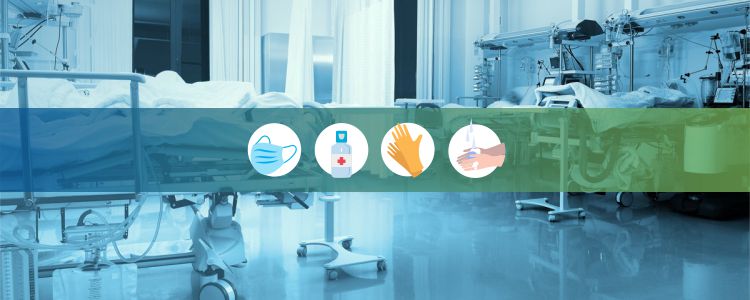Infection Control in the ICU

The care of critically ill patients in the Intensive Care Unit (ICU) is the most basic and mandatory feature of modern healthcare
Risk factors
- Patients in ICU are at risk for nosocomial infection and are related to the host characteristics and pre-existing active pathological conditions like agammaglobulinemia, immunosuppressive therapy or steroid usage, trauma, Chronic Obstructive Pulmonary Disease (COPD) and diabetes mellitus.
- Susceptibility to infection is influenced by the severity of underlying illness and ICU patients are more easily colonised by hospital flora due to changes in the body’s defence mechanism.
- Lack of enough space between beds for staff to reach patients and equipment easily. Separate patient rooms should be made available to prevent contamination.
- Prolonged period of invasive devices and improper handling of central intravenous catheters, Swan-Ganz catheters, Foley urinary catheters and mechanical ventilators.
- Resistant microorganisms – Patients in the ICU are often receiving high doses of various antibiotics which create an ideal environment for developing and transmitting resistant organisms like staphylococcus aureus, pseudomonas aeruginosa, coagulase-negative staphylococci, E. coli, enterococci, acinetobacter species, klebsiella species, streptococci and candida species which vary with the type of unit, patient population, procedures and associated equipment and antibiotic usage.
Many advances have been made to take care of the critically ill patients. Control and prevention measures are of utmost importance in every ICU. The risk of infection in the ICU can be controlled and prevented through isolating patients, washing hands, using protective clothing and providing education and training, especially to health care personnel ICU staff.
Hand washing
Frequent hand washing (before and after attending to a patient) is the most important thing in preventing infections which remains one of the most effective measures to reduce the pathogen population and the likelihood of cross contamination.
Medical Devices
Mechanical ventilation is common in ICU, frequent changing of tubings, preventing aspiration, proper handling by staff and daily monitoring for respiratory infections.
Clinicians should adhere to the protocols for the insertion and care of invasive devices, should also check and monitor the practices on a periodic basis.
Education
In order to benefit patients through advanced technology, the staff should be properly educated and coordination between all the staff members is very important for the quality of intensive care and is sometimes more effective.
The level of stress in the ICU is significantly higher than any other departments in a hospital.
Assigning one nurse per patient has been suggested in order to prevent transmission of pathogens from one patient to another and to improve the quality of nursing care.
It is very important for a staff member working in the ICU to understand how critically important it is to prevent the spread of contagious diseases. The hospital should provide full staffing and staff requesting for sick leave should be immediately approved.
Controlling Nosocomial Infections
Early diagnosis of a potentially contagious disease is very important, so physicians should be alert about the possibility.
Patients who are suspected of having an infection should be isolated after admission. Patients who are expected to remain in the ICU for a long time should be separated from the patients who are expected to stay for a shorter time.
Protective Barriers
Wearing gloves is more important than hand washing in the ICU. Often, a staff member forgets to change gloves when going from one patient to another and does not wash their hands after removing the gloves. The use of special clothing in the ICU for the staff is mandatory.

Dr Vijaya Bhaskar Reddypogu
Medical Director
OMNI Hospitals, Kurnool
